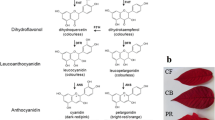Abstract
Anthocyanidins were identified in 28 Dendrobium species and hybrids selected for analysis based on colour and suitability in cut flower breeding. Flowers designated pink, red, maroon, orange, bronze, and brown in the trade were placed in RHS colour groups red-purple, purple-violet, violet on yellow, greyed-purple on yellow or yellow-orange, and brown. This colour range contained anthocyanins based on cyanidin, with peonidin occurring as a minor pigment. The colours of three blue genotypes, D. gouldii K280-6, D. biggibum ‘blue’, and D. Kultana ‘blue’, were light violet to purple by RHS standards and contained anthocyanins based on cyanidin. Peach-coloured flowers were classified as red or red-purple and included pelargonidin glycosides. Anthocyanin concentrations ranged from 0.13 to 0.18 μmoles/g FW in light lavender and peach, and up to 3.66 μmoles/g FW in brown. Combined cellular and vacuolar pH ranged narrowly from 4.67 to 5.09 among white, peach, lavender, and brown lines. Predominant copigments were flavonol glycosides based on kaempferol, quercetin, myricetin, and methylated derivatives. Flavonol aglycones and glycosylation sites differed little among two colour forms of D. gouldii and two D. Jaquelyn Thomas hybrids. Accumulation of quercetin, myricetin, and cyanidin indicated flavonoid 3' and 3',5' hydroxylation activities in several Dendrobium. Additional accumulation of isorhamnetin, syringetin, and peonidin indicated active flavonoid 3'- and 3',5'- O-methyltransferase enzymes.
Similar content being viewed by others
References
Arditti, J., 1992. Fundamentals of orchid biology, pp. 243–278. John Wiley & Sons, New York.
Arditti, J. & M.H. Fisch, 1977. Anthocyanins of the Orchidaceae: Distribution, heredity, functions, synthesis and localization. In: J. Arditti (Ed.), Orchid Biology: Reviews and Perspectives, pp. 117–155. Cornell University Press, Ithaca.
Chuck, G., T. Robbins, C. Nijjar, E. Ralston, N. Courtney-Gutterson & H.K. Dooner, 1993. Tagging and cloning of a petunia flower color gene with the maize transposable element Activator. Plant Cell 5: 371–378.
Courtney-Gutterson, N., 1993. Molecular breeding for color, flavor and fragrance. Sci Horticult 55: 141–160.
Courtney-Gutterson, N., 1994. The biologist's palette: genetic engineering of anthocyanin biosynthesis and flower color. In: B.E. Ellis, G.W. Kuroki & H. Stafford (Eds.), Genetic Engineering of Plant Secondary Metabolism, pp. 93–124. Plenum Press, New York.
de Vlaming, P., A.W. Schram & H. Wiering, 1983. Genes affecting flower colour and pH of flower limb homogenates in Petunia hybrida. Theor Appl Genet 66: 271–278.
Forkmann, G., 1991. Flavonoids as flower pigments: The formation of the natural spectrum and its extension by genetic engineering. Plant Breeding 106: 1–26.
Heller, W. & G. Forkmann, 1993. Biosynthesis of flavonoids. In: J.B. Harborne (Ed.), The Flavonoids: Advances in Research since 1986, pp. 499–536. Chapman & Hall, London.
Holton, T.A. & E.C. Cornish, 1995. Genetics and biochemistry of anthocyanin biosynthesis. Plant Cell 7: 1071–1083.
Jackson, D., K. Roberts & C. Martin, 1992. Temporal and spatial control of expression of anthocyanin biosynthetic genes in developing flowers of Antirrhinum majus. Plant J 2: 425–434.
Kamemoto, H., 1987. Four decades of research on orchid cytogenetics and breeding. Proc 12th World Orchid Conference, pp. 59–73. Tokyo, Japan.
Kamemoto, H. & T.D. Amore, 1990. Inheritance of semi-alba and alba in Dendrobium. In: D.G. Bonham & J. Kernohan (Eds.), Proc 13th World Orchid Conference 1990, pp. 242–244. 13 WOC Proceedings Trust, Auckland.
Kuehnle, A.R., 1996. Molecular biology of orchids. In: J. Arditti (Ed.), Orchid Biology: Reviews and Perspectives, VII. Kluwer Academic Publishers, Dordrecht (in press).
Lenz, L.W. & D.E. Wimber, 1959. Hybridization and inheritance in orchids. In: C.L. Withner (Ed.), The Orchids: A Scientific Survey, pp. 261–314. Ronald Press, New York.
Lowry, J.B. & S.C. Keong, 1973. A preliminary study of Malaysian orchid pigments. Malaysian J Sci 2(B): 115–121.
Mabry, T.J., K.R. Markham & M.B. Thomas, 1970. The systematic identification of flavonoids. Springer Verlag, New York.
Markham, K.R., 1982. Techniques of flavonoid identification. Academic Press, London.
Markham, K.R. & K.R.W. Hammett, 1994. The basis of yellow colouration in Lathyrus aphaca flowers. Phytochemistry 37: 163–165.
Martin, C. & T. Gerats, 1993. Control of flower colouration. In: B.R. Jordan (Ed.), The Molecular Biology of Flowering, pp. 219–255. CAB International, UK.
Nan, G.L. & A.R. Kuehnle, 1995. Genetic transformation in Dendrobium (Orchid). In: Y.P.S. Bajaj (Ed.), Biotechnology in Agriculture and Forestry, Vol. 34, Plant Protoplasts and Genetic Engineering VI, pp. 149–160. Springer Verlag, New York.
Schwinn, K.E., K.R. Markham & N.K. Given, 1994. Floral flavonoids and the potential for pelargonidin biosynthesis in commercial chrysanthemum cultivars. Phytochemistry 35: 145–150.
Schelpe, S. & J. Stewart, 1990. Dendrobiums, an introduction to the species in cultivation. Orchid Sundries, Stour Provost, Dorset.
Siegelman, H.W. & S.B. Hendricks, 1958. Photocontrol of alcohol, aldehyde, and anthocyanin production in apple skin. Plant Physiol 33: 409–413.
Thammasiri, K., C.S. Tang, H.Y. Yamamoto & H. Kamemoto, 1986. Carotenoids and chlorophylls in yellow-flowered Dendrobium species. Lindleyana 1: 215–218.
Wiering, H. & P. de Vlaming, 1984. Genetics of pollen and flower color. In: K.C. Sink (Ed.), Monographs on Theoretical and Applied Genetics 9: Petunia, pp. 49–67. Springer Verlag, Berlin.
Yong, H.H. & N.H. Chua, 1990. Isolation and characterisation of genes involved in the pigment biosynthesis of orchids. In: D.G. Bonham & J. Kernohan (Eds.), Proceedings of the 13th World Orchid Conference 1990, p. 265. 13th WOC Proceedings Trust, Auckland.
Author information
Authors and Affiliations
Rights and permissions
About this article
Cite this article
Kuehnle, A.R., Lewis, D.H., Markham, K.R. et al. Floral flavonoids and pH in Dendrobium orchid species and hybrids. Euphytica 95, 187–194 (1997). https://doi.org/10.1023/A:1002945632713
Issue Date:
DOI: https://doi.org/10.1023/A:1002945632713




